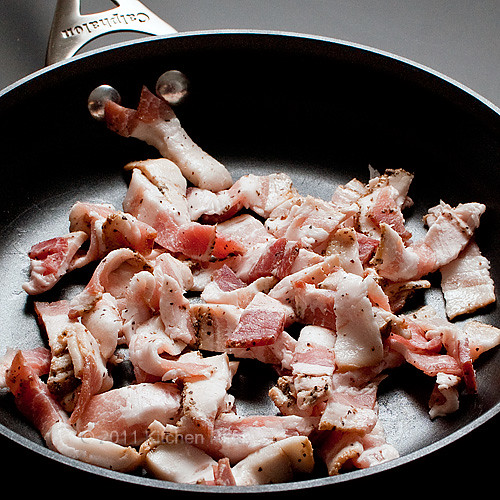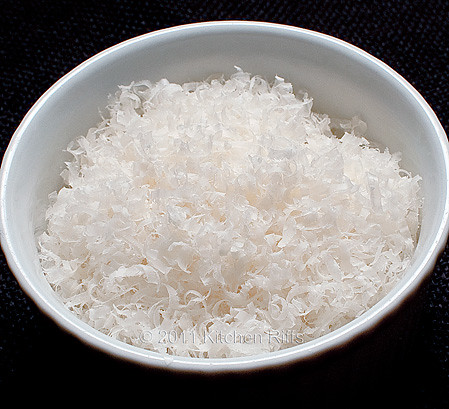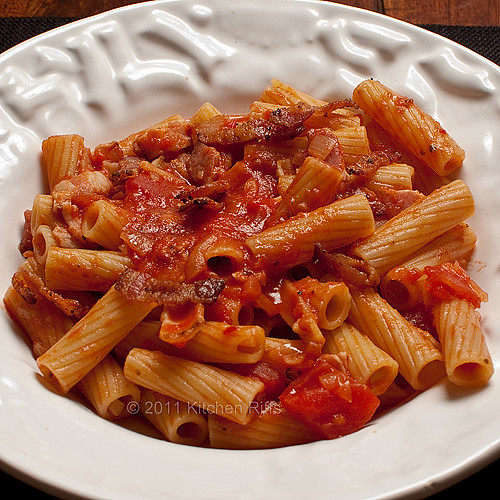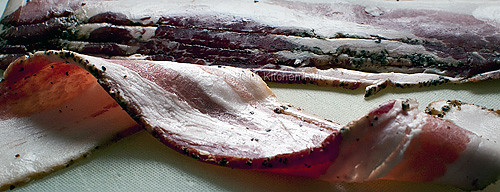Combining Two Italian Classics
Two of the more famous tomato-based pasta sauces can be found in pasta all’arrabbiata and pasta all’amatriciana.
Pasta all’arrabbiata — which means “angry” pasta — features a sauce that combines tomato, olive oil, and red pepper flakes (the “angry” part). Many recipes add garlic. This sauce traditionally is served over spaghetti, though other pasta shapes often substitute.
Pasta all’amatriciana, which originated in the Italian town of Amatrice, adds guanciale or pancetta and (usually) onions to the mix. But it leaves out the garlic. Guanciale is salt-cured pork jowl and pancetta is salt-cured pork belly — it’s like American bacon, except that it’s unsmoked and contains no sugar (which often is added to bacon). The traditional pasta for all’amatriciana is bucatini. This shape is similar to spaghetti, but has a small hole running down the center of the pasta strand.
Both of these sauces are excellent and quick cooking, and either one makes a great topping for pasta. But I like to mix the two recipes together to form a sauce that (to me at least) is even tastier.
Recipe: Pasta with Tomato and Bacon
Essentially, this dish is pasta all’amatriciana on steroids — with the addition of the garlic typically found in pasta all’arrabbiata.
I’ve been cooking variations of this recipe for over 20 years. I don’t remember where the idea came from, but I'm sure it was not original with me. There are so many riffs on both pasta all’arrabbiata and all’amatriciana that, somewhere along the line, somebody probably combined them and wrote about it. I probably got the idea while reading Giuliano Bugialli’s Bugialli on Pasta (link is to current edition; original edition published in 1988). My recipe is similar to his all’amatriciana. Or maybe I tasted the dish in a restaurant. No matter — it’s an excellent way to serve pasta.
This recipe yields enough sauce for 1 pound of pasta (which will serve 4). The sauce freezes well, so I often make a double batch.
I usually prepare this recipe in a wide-bottom saucepan or Dutch oven (3 – 4 quarts).
Ingredients
- ½ pound bacon sliced into pieces no more than ½ inch wide (a somewhat smaller quantity of bacon works too)
- 1 large onion (1 cup) peeled and diced
- 2 – 3 cloves garlic peeled and diced or sliced (see notes for why I like sliced)
- 2 tablespoons olive oil (may be optional; see notes)
- salt
- pepper
- ½ teaspoon red pepper flakes (or more to taste; I often add about a teaspoon)
- 2 teaspoons herb of choice (or to taste; dried oregano or thyme are my favorites)
- 1 28-ounce can crushed tomatoes (or whole or diced tomatoes; see notes)
- 1 pound pasta (I prefer a tubular shape with ridges like rigatoni; see notes)
- Fresh grated Parmesan or Romano cheese for garnish
 |
| Bacon in Step 1 |
Preparation
I usually sauté the bacon in a frying pan and sauté the onions in the saucepan I’ll use to cook the sauce. This speeds preparation and allows me to more easily control how much bacon fat I add to the sauce, but it makes for more cookware to wash. See notes if you prefer to prepare everything in just one pan.
- Slice bacon, place in cold frying pan on stove top, and turn heat to medium. Stir from time to time as bacon sautés to degree of doneness you prefer (10 – 15 minutes; I usually like my bacon crisp, so for me it’s 15 minutes).
- Meanwhile, dice onion and garlic.
- Put 3 – 4 quart wide-bottom saucepan or Dutch oven on stove top, turn heat to medium. When pan is hot, add oil, then add onion and garlic and season with salt and pepper. Turn heat to medium low and sauté, stirring occasionally, until onion is soft (6 – 8 minutes).
- Add red pepper flakes and herb of choice. Stir into mixture and let cook about 30 seconds. Then add tomato.
- About this time, the bacon should be ready. With a slotted spoon, remove bacon pieces and add to tomato. If you want a more intense bacon flavor, you may add some of the bacon fat to the tomato (I usually add a tablespoon or two).
- Simmer tomato mixture on medium to medium-low (just maintain a simmer) for 20 – 40 minutes (see notes for more about cooking time). If you judge the mixture to be too thick, add a little water. You can hold sauce over low heat for an additional half hour or so without any problem.
- About 15 minutes before sauce is ready, put large pot of water on burner and turn to high. When water comes to a boil, add salt to taste (I use kosher salt and add about a tablespoon for approximately 4 quarts of water), and add pasta. Stir once or twice so it doesn’t stick to bottom, and cook until almost done. Done means with a little bit of bite. I start testing after the pasta has been cooking 7 minutes.
- When you judge pasta is within a minute of being done (for me this is usually at the 8-minute mark), drain pasta, reserving a cup of pasta water. Return pasta to pot and place over low heat.
- Taste sauce for seasoning and adjust if necessary. Add sauce to pasta and stir to combine. Cook over low heat until pasta is done (about a minute). If sauce is too thick, dilute with some of the pasta cooking water.
- Serve with grated Parmesan or Romano cheese.
 |
| Parmesan Cheese |
Notes
The Difference Between Italian and Italian-American Pasta Dishes
This recipe is very Italian-American rather than classical Italian. How can we tell?
Well, first off, it calls for both garlic and onion. This combination is familiar in Italian-American tomato sauces, but seems to be quite rare in classical Italian cooking. One often finds either garlic or onion in Italian tomato sauce, but not both together — at least not in any Italian cookbook I’ve read. (Perhaps I just haven’t read enough cookbooks written by Italians?) I really enjoy the garlic-and-onion combo, so it makes frequent appearances in my recipes. This may constitute a terrible faux pas (or passo falso) in Italy, so any Italians who find my blog should feel free to roll their eyes and consider me a barbarian (I expect they’ll be too polite to upbraid me in the comments section).
Second, the sauce/pasta ratio in this recipe is more skewed towards “sauciness” than is usually the case with Italian recipes. Early Italian immigrants to the United States probably found many sauce ingredients (particularly meat) to be more plentiful — and less seasonal — than was the case in Italy. So they did what any smart shopper does at the market: They bought and used a lot of what was available. Thus, over time, some sauces probably became heartier and were served with a heavier hand than they had been in the “old country.”
More to the point, pasta in the United States is usually considered a main course. In Italy, it’s more often a preliminary or primo (slotted into the menu after the antipasto and before the main course). A heavily sauced dish might be inappropriate for a primo. But for a main course? You want substance, so bring on the sauce.
What does all of this mean? Probably nothing. Tastes vary.
I grew up eating “Italian” food that was in the Italian-American tradition, so that’s what I (and probably many people in the United States) prefer.
But then I’m a barbarian.
- If you want to use just one pan to cook the sauce, first sauté the bacon in the Dutch oven or sauce pan you’ll use to cook the sauce (you really need a wide-bottom sauce pan so the bacon and onions have room to sauté; I always use a 3-quart Dutch oven). When the bacon is done (10 – 15 minutes), remove with slotted spoon, add onion and garlic, and proceed with step 3 above. If you go the 1-pot route, the use of olive oil is optional. But the flavor of olive oil really adds to this dish. If I were using just the single pot, I’d probably skim off most of the bacon fat and add olive oil when sautéing the onion and garlic.
- This sauce is good when cooked for about 20 minutes. It is maybe a little better when allowed to cook 30 or 40 minutes. (I’m measuring from the point at which the tomato begins to simmer — not counting the time it takes to sauté the bacon and onion). My actual cooking time varies depending on how hungry I am.
- Why use bacon rather than pancetta? Partly because bacon is easier to find (though nowadays many supermarkets carry pancetta in their deli departments). Also, I like the smoky flavor bacon adds. And the sugar in bacon nicely counteracts the acidity of tomatoes (although I usually don’t add sugar to my tomato sauces).
- I like to use sliced (rather than diced) garlic. I enjoy the flavor of garlic, and I like to bite into a piece that’s large enough to get my attention. Many people would probably prefer their garlic finely diced.
- In Italy, cheese generally is not used in a dish that contains red pepper flakes. But Giuliano Bugialli tells us in his Bugialli on Pasta that all’amatriciana is an exception: It’s typically served with grated Parmesan or Romano cheese as a garnish.
- Most recipes for Italian tomato sauce call for whole, canned plum tomatoes, which break down as they cook. I prefer a sauce with more tomato oomph, so I usually use crushed (or sometimes diced) plum tomatoes. This makes for a thicker sauce, which I prefer (you can thin the sauce with water if you judge it to be too thick). Your preference might be different, so use whichever form of tomato you enjoy.
- I recommend using San Marzano tomatoes, if you can find a brand you like and consider affordable. They have fewer seeds, more flesh, and less acid than the typical plum tomato, so they’re superior for sauce making. Other types of tomatoes, including many supermarket brands, can also work well — though you may need to cook them a little longer to get the optimum flavor.
- Canned or fresh tomatoes? Fresh tomatoes are at their peak for only a month or two out of the year, so most of the time canned tomatoes are the better choice. Canned tomatoes are picked and processed at peak ripeness, so they usually have better flavor than fresh tomatoes that are out of season. Canned tomatoes produce a flavor that is less “bright” or “light,” however. So canned tomatoes do have a taste that is somewhat different (a “long-cooking” flavor), but one that is good nevertheless.
- Although a long-strand pasta like spaghetti or bucatini is traditional for this sauce, I prefer tubular pasta with ridges (rigatoni or a ribbed ziti or penne would be ideal). The sauce is chunky, so it goes better with a more substantial pasta shape. A ribbed shape works particularly well because the ridges allow sauce to cling to the pasta better. But use whatever shape you prefer.
 |
| Too Much Sauce? You Decide. |
The Difference Between Italian and Italian-American Pasta Dishes
This recipe is very Italian-American rather than classical Italian. How can we tell?
Well, first off, it calls for both garlic and onion. This combination is familiar in Italian-American tomato sauces, but seems to be quite rare in classical Italian cooking. One often finds either garlic or onion in Italian tomato sauce, but not both together — at least not in any Italian cookbook I’ve read. (Perhaps I just haven’t read enough cookbooks written by Italians?) I really enjoy the garlic-and-onion combo, so it makes frequent appearances in my recipes. This may constitute a terrible faux pas (or passo falso) in Italy, so any Italians who find my blog should feel free to roll their eyes and consider me a barbarian (I expect they’ll be too polite to upbraid me in the comments section).
Second, the sauce/pasta ratio in this recipe is more skewed towards “sauciness” than is usually the case with Italian recipes. Early Italian immigrants to the United States probably found many sauce ingredients (particularly meat) to be more plentiful — and less seasonal — than was the case in Italy. So they did what any smart shopper does at the market: They bought and used a lot of what was available. Thus, over time, some sauces probably became heartier and were served with a heavier hand than they had been in the “old country.”
More to the point, pasta in the United States is usually considered a main course. In Italy, it’s more often a preliminary or primo (slotted into the menu after the antipasto and before the main course). A heavily sauced dish might be inappropriate for a primo. But for a main course? You want substance, so bring on the sauce.
What does all of this mean? Probably nothing. Tastes vary.
I grew up eating “Italian” food that was in the Italian-American tradition, so that’s what I (and probably many people in the United States) prefer.
But then I’m a barbarian.
You may also enjoy reading about:
Pasta Puttanesca
Pasta Cacio e Pepe
Salade Niçoise
Spinach Salad with Hot Bacon Dressing





I absolutely love spicy tomato sauce on my pasta - this looks delicious! I'd love for you to submit this to the M&T Spotlight at http://www.makeandtakes.com/spotlight
ReplyDeleteHow is it that it's breakfast time and all I want is this!??!
ReplyDeleteGreat blog; happy I found you!
Mary xx
Delightful Bitefuls
Laurel and Mary,
ReplyDeleteThanks for your kind comments!
BTW, I hate to admit it, but leftover pasta is a great breakfast dish . . .
Yum yum yum, this sounds amazing! Love quick pasta sauces, and this sounds so delicious. Gorgeous photos, too!
ReplyDeleteHi Sara, thanks for the comments. This really is a good sauce, one of my favorites. Glad you enjoy the photographs.
ReplyDeleteReally good! I made the recipe, appreciated the tips and recommend this to anyone who likes good food, added advantage, delicious in a short time frame!
ReplyDeleteHi Cheryl, thanks for your comment. Glad you enjoyed the recipe. It's one of my favorites for a quick pasta dinner.
ReplyDeleteArgh - no chilli flakes - just chilli power in house. How much should I use?
ReplyDeleteHi Anonymous, I assume by chilli powder you mean chili powder, that blend of dried chilies and spices such as cumin, coriander, etc. that one uses in the Mexican dish, chili? You could use that, but the flavor profile is going to be different. Frankly, I'd skip it, and just do without the "ping" the pepper flakes give it. However, if you have "chile" powder on hand - the dried powder of the chile plant (red pepper flakes) - you could substitute that. How much to use? Depends on how hot. For cayenne pepper, I'd use no more than 1/4 teaspoon. Best suggestion is to add just a bit, taste, then add a bit more after the sauce has cooked a bit if you haven't add enough.
ReplyDeleteMuch more here than you really need to know, I know. I actually discuss in some detail the difference between chili powder and chili powder in my post on Vegetarian Chili.
Thanks for the comment!
I'm so glad I found this recipe! I'm taking part of a blogger cooking challenge and this month's challenge was finding a spaghetti dish that another blogger made. I found this and thought it was perfect and just what I was looking for! The cooking challenge is set and scheduled for March 7th, so if you get a chance, stop on by and hopefully, it will bring traffic to your blog as well :) Thanks for the recipe, it was delicious!
ReplyDeleteHi Chels, good luck with the challenge! I'll definitely stop by your blog and check it out. Thanks for using my recipe, the pin on Pinterest, and for your comment.
ReplyDelete